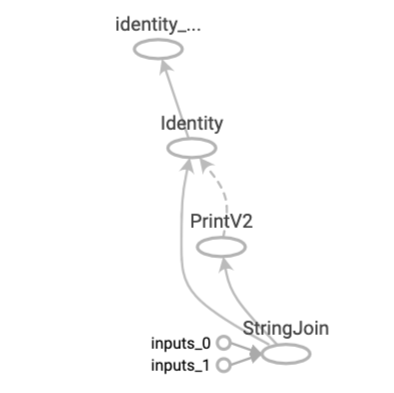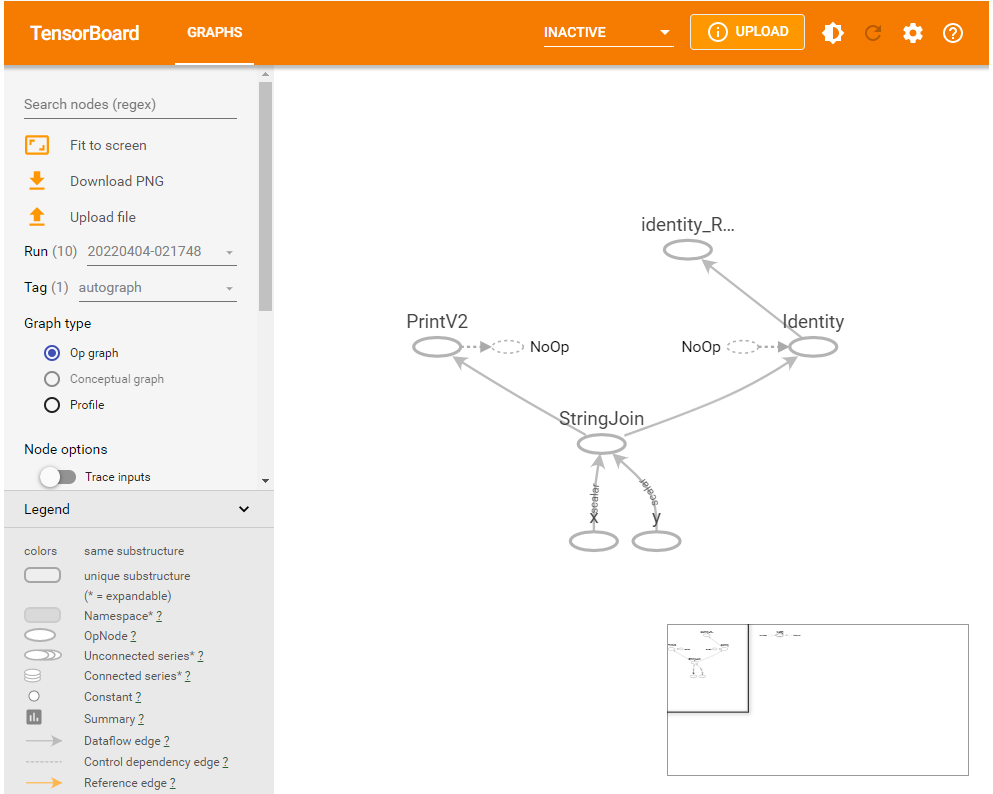2-2三种计算图——eat_tensorflow2_in_30_days
有三种计算图的构建方式:静态计算图、动态计算、以及Autograph
在TensorFlow1.0时代,采用的是静态计算图,需要先使用TensorFlow的各种算子创建计算图,然后再开启一个会话Session,显式执行计算图
而在TensorFlow2.0时代,采用的是动态计算图,即每使用一个算子后,该算子会被动态加入到隐含的默认计算图中立即执行得到结果,而无需开启Session
使用动态计算图即Eager Execution的好处是方便调试程序,它会让TensorFlow代码的变现和Python原生代码的表现一致,写起来像numpy一样,各种日志打印,控制流全部都是可以使用的
使用动态计算图的缺点是运行效率相对会低一些。因为使用动态图会有许多次Python进程和TensorFlow的C++进程之间的通信。而静态计算图构建完成之后几乎全部在TensorFlow内核上使用C++代码执行,效率更高。此外静态计算图会对计算步骤进行一定的优化,剪去和结果无关的计算步骤
如果需要在TensorFlow2.0中使用静态计算图,可以使用@tf.function装饰器将普通的Python函数转换成对应的TensorFlow计算图构建代码。运行该函数就相当于在TensorFlow1.0中用Session执行代码。使用tf.function构建静态计算图的方式叫作Autograph
计算图简介#
计算图由节点(nodes)和线(edges)组成
节点表示操作符Operator,或者称之为算子,线表示计算间的依赖
实线表示有数据传递依赖,传递的数据即张量
虚线通常可以表示控制依赖,即执行先后顺序
静态计算图#
在TensorFlow1.0中,使用静态计算图分两步,第一步定义计算图,第二步在会话中执行计算图
# TensorFlow 1.0静态计算图范例
import tensorflow as tf
#定义计算图
g = tf.Graph()
with g.as_default():
#placeholder为占位符,执行会话时候指定填充对象
x = tf.placeholder(name='x', shape=[], dtype=tf.string)
y = tf.placeholder(name='y', shape=[], dtype=tf.string)
z = tf.string_join([x,y],name = 'join',separator=' ')
#执行计算图
with tf.Session(graph = g) as sess:
print(sess.run(fetches = z,feed_dict = {x:"hello",y:"world"}))
TensorFlow2.0为了确保对老版本TensorFlow项目的兼容性,在tf.compat.v1子模块中保留了对TensorFlow1.0那种静态计算图构建风格的支持,可称之为怀旧版静态计算图,已经不推荐使用了
import tensorflow as tf
g = tf.compat.v1.Graph()
with g.as_default():
x = tf.compat.v1.placeholder(name='x', shape=[], dtype=tf.string)
y = tf.compat.v1.placeholder(name='y', shape=[], dtype=tf.string)
z = tf.strings.join([x, y], name='join', separator=' ')
with tf.compat.v1.Session(graph=g) as sess:
# fetches的结果非常像一个函数的返回值,而feed_dict中的占位符相当于函数的参数序列
result = sess.run(fetches=z, feed_dict={x: 'hello', y: 'world'})
print(result)
"""
b'hello world'
"""
动态计算图#
在TensorFlow2.0中,使用的是动态计算图和Autograph
在TensorFlow1.0中,使用静态计算图分两步,第一步是定义计算图,第二步会在会话中执行计算图
动态计算图已经不区分计算图的定义和执行了,而是定义后立即执行,因此称之为Eager Execution,Eager这个英文单词的愿意是“迫不及待的”,也就是立即执行的意思
# 动态计算图在每个算子处都进行构建,构建后立即执行
x = tf.constant('hello')
y = tf.constant('world')
z = tf.strings.join([x, y], separator=' ')
tf.print(z)
"""
hello world
"""
# 可以将动态计算图代码的输入和输出关系封装成函数
def strjoin(x, y):
z = tf.strings.join([x, y], separator=' ')
tf.print(z)
return z
result = strjoin(tf.constant('hello'), tf.constant('world'))
print(result)
"""
hello world
tf.Tensor(b'hello world', shape=(), dtype=string)
"""
TensorFlow2.0的Autograph#
动态计算图运行效率相对较低
可以用@tf.function装饰器将普通Python函数转换成TensorFlow1.0对应的静态计算图构建代码
在TensorFlow1.0中,使用计算图分两步,第一步定义计算图,第二步在会话中执行计算图
在TensorFlow2.0中,如果采用Autograph的方式使用计算图,第一步定义计算图变成了定义函数,第二步执行计算图变成了调用函数
不需要使用会话了,一切都像原生的Python语法一样自然
实践中,我们一般会先用动态计算图调试代码,然后在需要提高性能的地方利用@tf.function切换成Autograph获得更高的效率
当然@tf.function的使用需要遵循一定的规范,后面章节重点介绍
import tensorflow as tf
# 使用autograph构建静态计算图
@tf.function
def strjoin(x, y):
z = tf.strings.join([x, y], separator=' ')
tf.print(z)
return z
result = strjoin(tf.constant('hello'), tf.constant('world'))
print(result)
"""
hello world
tf.Tensor(b'hello world', shape=(), dtype=string)
"""
import datetime
# 创建日志
import os
# stamp = datetime.datetime.now().strftime("%Y%m%d-%H%M%S")
# logdir = os.path.join('data', 'autograph', stamp)
# 在Python3下建议使用pathlib修正操作系统的路径
from pathlib import Path
stamp = datetime.datetime.now().strftime("%Y%m%d-%H%M%S")
logdir = str(Path('./data/autograph/' + stamp))
writer = tf.summary.create_file_writer(logdir)
# 开启autograph跟踪
tf.summary.trace_on(graph=True, profiler=True)
# 执行autograph
result = strjoin(tf.constant('hello'), tf.constant('world'))
# 将计算图信息写入日志
with writer.as_default():
tf.summary.trace_export(
name='autograph',
step=0,
profiler_outdir=logdir
)
"""
hello world
"""
# 启动tensorboard在jupyter中的魔法命令
%load_ext tensorboard
# 启动tensorboard
%tensorboard --logdir ./data/autograph/
作者:lotuslaw
出处:https://www.cnblogs.com/lotuslaw/p/16098262.html
版权:本作品采用「署名-非商业性使用-相同方式共享 4.0 国际」许可协议进行许可。






【推荐】国内首个AI IDE,深度理解中文开发场景,立即下载体验Trae
【推荐】编程新体验,更懂你的AI,立即体验豆包MarsCode编程助手
【推荐】抖音旗下AI助手豆包,你的智能百科全书,全免费不限次数
【推荐】轻量又高性能的 SSH 工具 IShell:AI 加持,快人一步
· 阿里最新开源QwQ-32B,效果媲美deepseek-r1满血版,部署成本又又又降低了!
· 开源Multi-agent AI智能体框架aevatar.ai,欢迎大家贡献代码
· Manus重磅发布:全球首款通用AI代理技术深度解析与实战指南
· 被坑几百块钱后,我竟然真的恢复了删除的微信聊天记录!
· 没有Manus邀请码?试试免邀请码的MGX或者开源的OpenManus吧